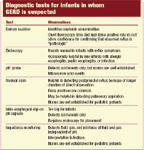Esophageal impedance monitoring: What a new test tells us about infants who reflux
Initial clinical studies of a tool that measures impedance in the esophagus provide new insight into acid reflux disease.
DR. SONDHEIMER is professor of pediatrics, University of Colorado Health Sciences Center, and chief of pediatric gastroenterology, hepatology, and nutrition at The Children's Hospital, Denver. She has nothing to disclose in regard to affiliations with, or financial interests in, any organization that may have an interest in any part of this article.
The offices of pediatric gastroenterologists are filled with infants whose pediatricians have diagnosed gastroesophageal reflux disease. Infants with arching, crying, spitting, and food refusal are being diagnosed with GERD. Although these babies are treated with acid blockers and motility agents that are promoted as curative, a little digging shows that no double-blind controlled study has confirmed the efficacy of these drugs in controlling these symptoms in infants.1-3
No doubt, acid blockade cures esophagitis and produces dramatic changes in pH probe studies. But most infants with reflux do not have esophagitis, and treating a test result does not guarantee that symptoms will be controlled. There is a lack of pathophysiologic data explaining why infants reflux and whether GE reflux causes these common, frustrating symptoms.
Testing for reflux
The tests most commonly used to document pathologic GE reflux in infants or to correlate symptoms with acid reflux are the barium radiograph, prolonged intraluminal esophageal pH monitoring, and upper GI endoscopy. Used less often is the esophageal nuclear scan, which monitors the accumulation of radioisotope in the esophagus after oral administration of a radiolabeled meal.
Another new method of monitoring esophageal acid reflux uses an intraluminal esophageal pH capsule (Bravo Capsule). This small, wireless pH probe is clipped to the side wall of the esophagus during endoscopy and transmits pH data to a small external recorder for up to 48 hours.

For more than 30 years, physicians have measured GE reflux by prolonged monitoring of esophageal pH. Such pH probe studies accurately describe the frequency and duration, but not the volume, of acid reflux events. Experience with pH recordings has yielded a consensus on how much acid reflux is normal. Roughly speaking, it is probably pathologic if a child spends more than 6% to 10% of a 24-hour period with acid material in the esophagus. Acid reflux during sleep is abnormal. More than three or four episodes of acid reflux lasting more than five minutes in 24 hours is abnormal.
Although pH monitoring is the best diagnostic tool available, physicians have long known that these studies tell only part of the story. The pH probe cannot detect postprandial reflux because the stomach contents are buffered by food. The probe cannot measure the volume of the refluxate, and it cannot measure burps when only air escapes from the stomach. Although pH studies correlate well with the presence and severity of esophagitis, this condition is rarely present in infants with reflux. Regrettably, pH probe studies have not correlated well with typical infant symptoms linked to reflux-fussiness, arching, food refusal, spitting, and cough.
What is impedance monitoring?
Impedance is the resistance to the flow of current between two points. Basic physics reminds us that resistance to current flow is usually higher between electrodes submerged in air than between electrodes submerged in liquid. Using this principle, researchers in industry and clinical medicine have developed an instrument capable of measuring impedance continuously at multiple sites in the esophagus.